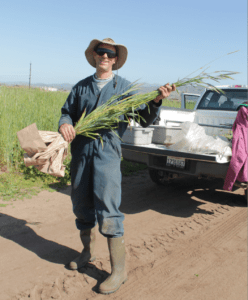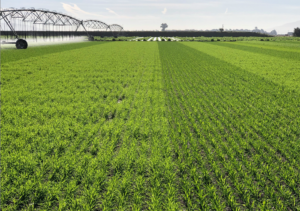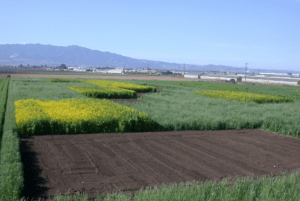Written by Elizabeth Tobey
Dr. Eric Brennan is an example of what can happen when researchers are in the right place at the right time to lend their expertise to policy decisions.

Dr. Eric Brennan with cereal cover crop samples from Ag Order 4.0 Trials
Brennan is a research horticulturist at the USDA Agricultural Research Service in Salinas, California. He specializes in organic farming systems and climate-smart agriculture, and the policy decision he was able to weigh in on was Ag Order 4.0, a regulatory program that protects groundwater resources from agricultural runoff. This regulation affects over 540,000 acres of irrigated land in the central coast region of California and applies to growers who operate irrigated lands, animal feeding operations, or nurseries. In the press release when the regulatory program was launched, it says “The requirements in Ag Order 4.0 protect human health, protect and restore the beneficial uses of surface and groundwater, and achieve water quality objectives specified in the Central Coast Basin Plan by minimizing nitrogen discharges to groundwater, minimizing nutrient, pesticide and sediment discharges to surface water. The order also requires the protection of riparian and wetland habitat.”
The day before the Ag Order 4.0 regulation was to be adopted, Brennan was given 10 minutes to comment on the regulation. His testimony was based on his long-term systems research on cover crops and compost use in intensive organic vegetable production systems. His presentation is available to watch here. For Brennan, it was the experience of truly being in the right place at the right time, and with the right research to share. “This was the most important presentation I’ve given in my career,” Brennan later said. In ten minutes he succinctly and convincingly argued that the regulation was scientifically flawed and presented cover crop data from the long-term organic system study in Salinas to explain how to fix it.
During the Q&A that followed the presentation, all 5 board members unanimously voted to change the regulation as he had suggested. “It was truly amazing to witness this happen live,” Brennan said. One of Brennan’s colleagues at UC Berkeley even called the hearing a “nail-biter.” The full three-hour adoption hearing is available to watch here.

Trials of cover crop for Ag Order 4.0
Ag Order 4.0, was adopted in 2021 by the Central Coast Regional Water Quality Control Board. In order to meet its goals of protecting water and minimizing discharges this regulatory program establishes nitrogen discharge targets and limits over time, ratcheting down allowed values of N applied minus N removed from 500 pounds per acre by the end of 2023 to 50 pounds per acre by the end of 2051. It provides incentives for farmers to use cover crops, compost, organic fertilizers, and third-party programs to comply with the regulation and protect the environment. And, in part due to Brennan’s informed testimony, and input from colleagues like Richard Smith with the University of California Cooperative Extension, growers can get credits for using cover crops that have a minimum biomass of 4,500 pounds per acres, and a carbon-to-nitrogen ratio equal to or greater than 20 to 1.
Soon after the Ag Order 4.0 regulation was adopted, Brennan and Smith set up several extensive trials funded by the California Leafy Greens Research Board to provide farmers with simple ways to meet the regulatory requirements. Some of this has been published in this paper on predicting cover crop biomass and this 8 minute video. Eric also shares some of his research findings on cover crop nitrogen credits and estimating cereal cover crop biomass in this recent 10 minute video.

Various cover crops growing in the long-term organic systems trial in Salinas
For more of Brennan’s thoughts on these topics, you can read this page on his USDA Agricultural Research Service website, titled My Philosophy or Views on Sustainability & Organic Agriculture.
We applaud Brennan for putting his research into actionable use through civic engagement. His story is a great example of the type of practical research at the USDA-ARS that is helping organic and conventional farmers improve the sustainability of their systems, and informing policy makers so regulations are based in reality and farmers get the support and information they need.


